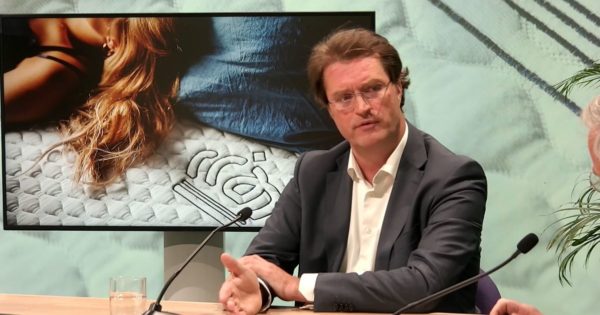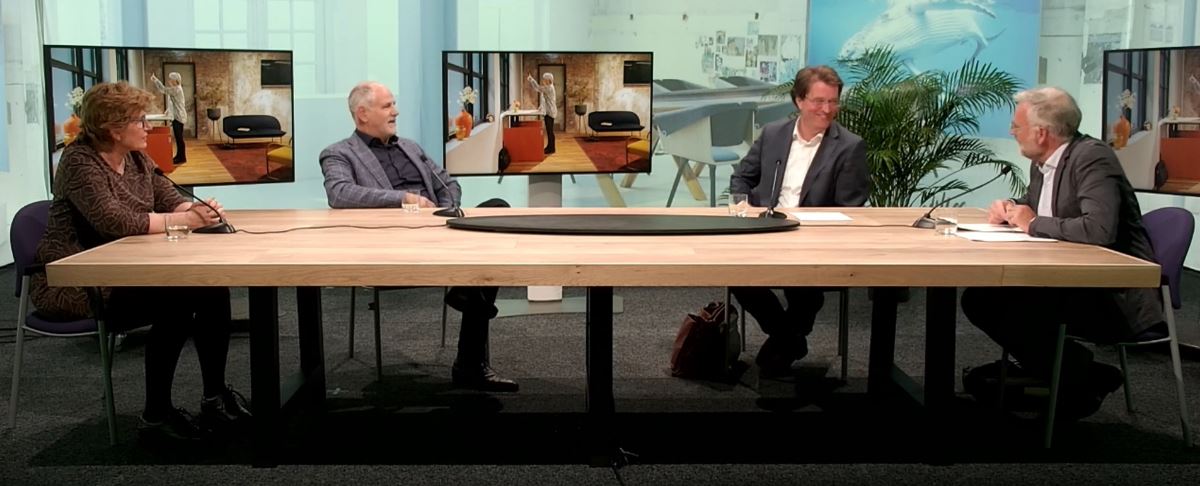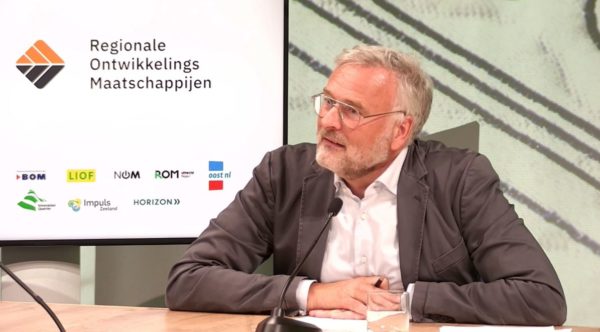By 2050, our economy must be completely circular. In other words, a world without waste. But as a company, how can you ensure that raw materials and products retain their value? To find the answers, the regional development companies (ROMs) organized a webinar on circular entrepreneurship last June 23, led by journalist and writer Jeroen Smit. NOM, on behalf of the other ROMs, hosted this webinar.
The title was as tantalizing as it was clear: "Those who are not working on circularity will soon cease to exist." That the challenge is great was evident when Smit kicked off with a few facts. In 2019, he explained, we consumed more than 100 billion tons of material worldwide for the first time. 'Currently, about 9% of that is reused. The recent Circularity Gap Report revealed that circularity must double by 2032 to meet the Paris climate goals.' So work to be done. But a hopeless mission, no, it is certainly not. The activities of Auping and Vepa make that abundantly clear. Both companies have long been pioneers in the field of circular entrepreneurship. That is why Auping director Jan Joost Bosman and Janwillem de Kam, director of Vepa, have been invited to share their experiences and insights. Dina Boonstra, director of the NOM, also joined us this afternoon.
100% recyclable mattress
Auping drew attention last year with its successful campaign "The story of 1.5 million mattresses," designed to make consumers aware of the enormous waste problem created by discarded mattresses. 'A large proportion of those mattresses, made of glued plastic and latex, among other things, are burned or end up in landfills,' Bosman emphasizes. 'With all the environmental consequences that entails. We believe that as an industry we have a responsibility to deal with this and develop circular product concepts. That is why we are fully committed to making our product range fully circular by 2030.' In 2018, an important step was already taken by Auping. The Deventer-based bed and mattress manufacturer introduced the world's first 100% recyclable mattress that year. 'The special thing about our approach is that we make the technology available to competitors and retailers. Simply because you can only accelerate the transition by working together. We do agree that we will receive a small fee per mattress sold. That way we create an extra cash flow that we use to invest in new production facilities. So the knife cuts both ways.'
Recycled PET bottles
 Office and contract furniture manufacturer Vepa, as mentioned, is also leading the way. Prompted by the credit crisis in 2008, the family business, with branches in Hoogeveen and Emmen, started thinking more and more about making its production process more sustainable. 'To cut costs and produce more cheaply, many companies fled to China at the time,' says De Kam. 'As a family business, we absolutely did not want that. But we did know that things had to be done differently. That made us decide to give sustainability an even more prominent place in our business operations. But how do you actually innovate circularly? No, that was not entirely clear to us. So we asked a professor of sustainable design to advise us. Shortly thereafter, we came into contact with waste processor Sita. The company had a new installation in Rotterdam to separate plastic. However, they were not getting rid of that plastic. Can you do something with that? Together we started looking at circular applications. In 2016, that resulted in a sustainable chair made from recycled PET bottles. Since then, we have continued to develop in the field of circularity.'
Office and contract furniture manufacturer Vepa, as mentioned, is also leading the way. Prompted by the credit crisis in 2008, the family business, with branches in Hoogeveen and Emmen, started thinking more and more about making its production process more sustainable. 'To cut costs and produce more cheaply, many companies fled to China at the time,' says De Kam. 'As a family business, we absolutely did not want that. But we did know that things had to be done differently. That made us decide to give sustainability an even more prominent place in our business operations. But how do you actually innovate circularly? No, that was not entirely clear to us. So we asked a professor of sustainable design to advise us. Shortly thereafter, we came into contact with waste processor Sita. The company had a new installation in Rotterdam to separate plastic. However, they were not getting rid of that plastic. Can you do something with that? Together we started looking at circular applications. In 2016, that resulted in a sustainable chair made from recycled PET bottles. Since then, we have continued to develop in the field of circularity.'
Kentering
"Is the consumer actually willing to pay more for stuff that is made circular?", discussion leader Smit wants to know. Good question, because just look at electric cars. When the subsidy disappears, you immediately see a decrease in demand. Yet De Kam is slowly seeing a turnaround. 'I notice that a growing number of consumers feel the urgency. They are increasingly willing to pay for circular products. You just have to do more to successfully market such a product. Above all, you have to tell the story well.' Bosman detects the same trend. 'Now it is still something new,' he says, 'but I expect that eventually all the products we produce and consume worldwide will be based on modular reusable concepts. Simply because both producers and consumers see the need.'
Refurbishing and renovating
Circularity involves more than just using products after use as raw materials for new products or materials. If you can no longer reuse products one-to-one, you can also look at other circular solutions such as refurbishment and renovation. 'Our customers can return their office furniture to us at the end of the usage phase,' says De Kam. 'That also applies to furniture purchased from other suppliers. We will reupholster, repaint and tidy that furniture, for example, so that it looks like new again. Customers then receive a voucher from us that they can exchange for another product. Is this concept catching on? Yes indeed. Indeed, we have numerous customers who prefer to buy second-hand furniture.'
Other revenue models
 In addition to new ways of thinking and collaborating, the circular economy also requires different revenue models. For example, Auping launched Bedzzzy: a startup that makes it possible to lease circular mattresses. 'Consumers can take out a flexible sleep subscription and lease a sustainable mattress for €12.50 a month,' Bosman clarifies. 'That means you get monthly income per mattress, even though you have to make the product and do marketing. It took us five years to get the model profitable. So you have to pre-finance for five years. You need, in short, working capital funding. Only: that's almost impossible to get done. Unlike cars, for example, there is no residual value in mattresses. After all, there is no second-hand market for them. Banks, but also the regional development companies, should be more open to funding such initiatives and projects with risk capital.'
In addition to new ways of thinking and collaborating, the circular economy also requires different revenue models. For example, Auping launched Bedzzzy: a startup that makes it possible to lease circular mattresses. 'Consumers can take out a flexible sleep subscription and lease a sustainable mattress for €12.50 a month,' Bosman clarifies. 'That means you get monthly income per mattress, even though you have to make the product and do marketing. It took us five years to get the model profitable. So you have to pre-finance for five years. You need, in short, working capital funding. Only: that's almost impossible to get done. Unlike cars, for example, there is no residual value in mattresses. After all, there is no second-hand market for them. Banks, but also the regional development companies, should be more open to funding such initiatives and projects with risk capital.'
Encourage and facilitate
 NOM director Dina Boonstra nods in agreement. Like the other regional development companies, NOM also tries to stimulate and facilitate circular entrepreneurship wherever possible. 'So it is also part of our role to come up with products that help accelerate the transition,' she argues. 'Especially when certain forms of funding are not or hardly available in the market. That's where we will definitely look into that. At the same time, we can point entrepreneurs to interesting subsidy opportunities and help set up relevant partnerships throughout the chain.'
NOM director Dina Boonstra nods in agreement. Like the other regional development companies, NOM also tries to stimulate and facilitate circular entrepreneurship wherever possible. 'So it is also part of our role to come up with products that help accelerate the transition,' she argues. 'Especially when certain forms of funding are not or hardly available in the market. That's where we will definitely look into that. At the same time, we can point entrepreneurs to interesting subsidy opportunities and help set up relevant partnerships throughout the chain.'
Step by step
Finally, Smit wants to know from Bosman and De Kam how they manage to stay ahead again and again. 'By really building on your primary production processes step by step,' replies De Kam. 'It is virtually impossible to plan where you want to be in 2050. Technological developments happen so fast that you never know what will happen in the meantime. You have to look broadly and think in small steps.' Bosman adds, "There is simply no alternative. Failure is not an option. If this mattress transition doesn't succeed, we as a company really have a problem. We are building a bridge as we walk across it. You just have to do it. In a sensible way and together with the whole chain. Because on your own you're never going to make it.'

